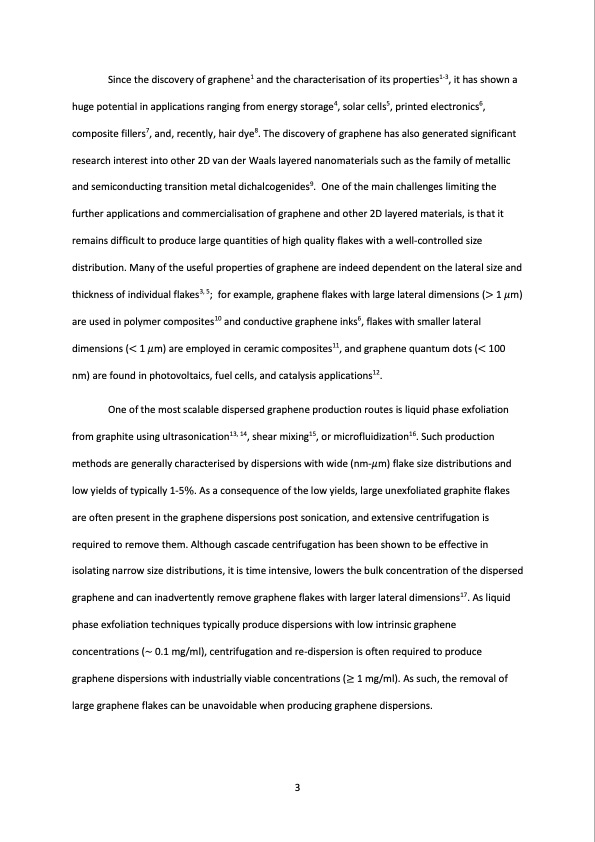
PDF Publication Title:
Text from PDF Page: 003
Since the discovery of graphene1 and the characterisation of its properties1-3, it has shown a huge potential in applications ranging from energy storage4, solar cells5, printed electronics6, composite fillers7, and, recently, hair dye8. The discovery of graphene has also generated significant research interest into other 2D van der Waals layered nanomaterials such as the family of metallic and semiconducting transition metal dichalcogenides9. One of the main challenges limiting the further applications and commercialisation of graphene and other 2D layered materials, is that it remains difficult to produce large quantities of high quality flakes with a well-controlled size distribution. Many of the useful properties of graphene are indeed dependent on the lateral size and thickness of individual flakes3, 5; for example, graphene flakes with large lateral dimensions (> 1 𝜇m) are used in polymer composites10 and conductive graphene inks6, flakes with smaller lateral dimensions (< 1 𝜇m) are employed in ceramic composites11, and graphene quantum dots (< 100 nm) are found in photovoltaics, fuel cells, and catalysis applications12. One of the most scalable dispersed graphene production routes is liquid phase exfoliation from graphite using ultrasonication13, 14, shear mixing15, or microfluidization16. Such production methods are generally characterised by dispersions with wide (nm-𝜇m) flake size distributions and low yields of typically 1-5%. As a consequence of the low yields, large unexfoliated graphite flakes are often present in the graphene dispersions post sonication, and extensive centrifugation is required to remove them. Although cascade centrifugation has been shown to be effective in isolating narrow size distributions, it is time intensive, lowers the bulk concentration of the dispersed graphene and can inadvertently remove graphene flakes with larger lateral dimensions17. As liquid phase exfoliation techniques typically produce dispersions with low intrinsic graphene concentrations (~ 0.1 mg/ml), centrifugation and re-dispersion is often required to produce graphene dispersions with industrially viable concentrations (≥ 1 mg/ml). As such, the removal of large graphene flakes can be unavoidable when producing graphene dispersions. 3PDF Image | Cavitation Liquid Phase Exfoliation of Graphene

PDF Search Title:
Cavitation Liquid Phase Exfoliation of GrapheneOriginal File Name Searched:
1809-07630.pdfDIY PDF Search: Google It | Yahoo | Bing
Salgenx Redox Flow Battery Technology: Power up your energy storage game with Salgenx Salt Water Battery. With its advanced technology, the flow battery provides reliable, scalable, and sustainable energy storage for utility-scale projects. Upgrade to a Salgenx flow battery today and take control of your energy future.
| CONTACT TEL: 608-238-6001 Email: greg@infinityturbine.com | RSS | AMP |